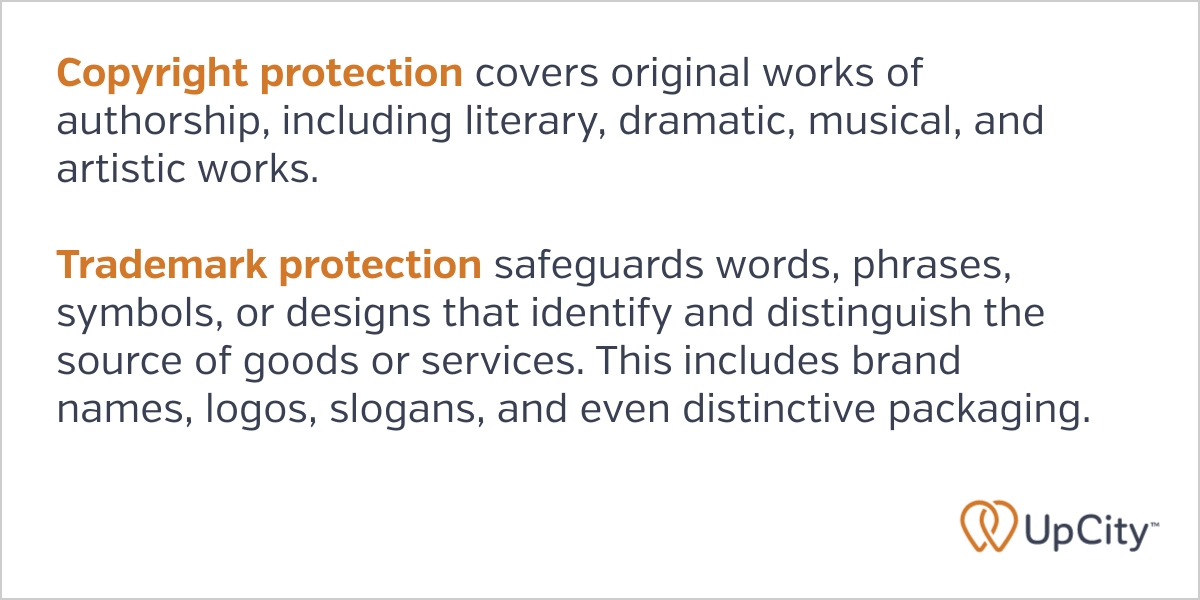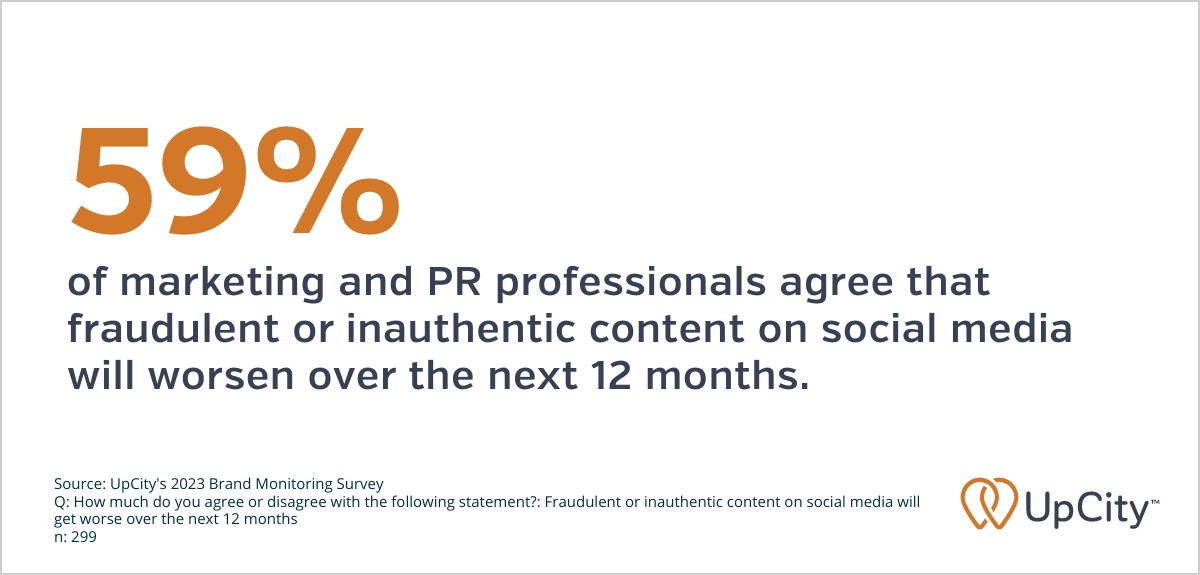As a business manager, it’s easy to focus solely on building your brand and growing your customer base. However, when you start a business or launch a new product or service, it is essential to consider the legal protection of your intellectual property. With the rise of social media and online platforms, the risk of brand infringement and content theft has never been higher. According to UpCity’s 2023 Brand Monitoring Survey,* 49% of marketing and PR professionals have witnessed fraudulent company or brand accounts on social media, and 45% have seen fraudulent company spokespeople.
Understanding the nuances of copyright, brand, and trademark protection is crucial for securing your brand’s future. The legal safeguards of a trademark or copyright shield your creative works and brand elements and provide a solid foundation for growth and expansion. This guide will demystify the brand and trademark protection, helping you navigate the complexities of intellectual property law with confidence.
What is the difference between copyright and trademark protection?
Before diving into the specifics of brand protection, it’s essential to understand the fundamental differences between copyright and trademark protection.

Copyright protection covers original works of authorship, including literary, dramatic, musical, and artistic works. This encompasses everything from books and songs to software code and architectural designs. Copyright protection is automatic upon creation of the work, although registration provides additional benefits.
Trademark protection safeguards words, phrases, symbols, or designs that identify and distinguish the source of goods or services. This includes brand names, logos, slogans, and even distinctive packaging. Unlike copyright, trademark rights are typically established through use in commerce, but registration offers stronger legal protection.
The key distinction lies in their purpose: copyright protects creative expression, while trademarks protect brand identity and consumer recognition.
Why is copyright and trademark protection important?
Understanding why brand protection is important is crucial for small and midsize businesses. Brand and trademark protection offer numerous benefits that address key business challenges and contribute to long-term success.
Legal protection
One of the primary reasons for brand and trademark protection is the legal safeguard it provides. By securing copyrights and trademarks, businesses can protect their brand name from unauthorized use, ensuring their intellectual property remains exclusively theirs. This legal protection helps prevent competitors from using similar branding, which could confuse customers and dilute the brand’s identity. Protecting your brand name through legal means is essential for maintaining its integrity and value.
Brand recognition
Brand name protection is vital for building and maintaining brand recognition. Trademarks help distinguish your products and services from those of others, making it easier for customers to identify and trust your brand. Consistent use of trademarks across all marketing materials reinforces brand identity and fosters customer loyalty. Protecting a brand through trademarks ensures that your brand remains unique and recognizable in the marketplace.
Increased revenue
Copyright and trademark protection can lead to increased revenue opportunities. By securing exclusive rights to your intellectual property, you can license your brand name, logos, and other assets to third parties. This not only generates additional income but also expands your brand’s reach. Protecting your brand name through licensing agreements can be a lucrative strategy for growth.
Competitive advantage
In a crowded market, having a protected brand name gives you a competitive edge. Trademarks prevent competitors from using similar names or logos, ensuring that your brand stands out. This exclusivity helps attract and retain customers, as they can easily differentiate your brand from others. Brand rights protection is a strategic move to maintain and enhance your market position.
Licensing opportunities
Trademark protection opens up various licensing opportunities. By licensing your trademarks, you can allow other businesses to use your brand name and logos under specific conditions. This not only generates revenue but also helps in expanding your brand’s presence in new markets. Protecting your brand name through licensing can be a powerful tool for business growth and diversification.
Global protection
For businesses looking to expand internationally, global brand name protection is essential. Trademarks are recognized globally, allowing you to protect your brand in different countries. This global protection ensures that your brand remains secure and consistent across various markets, preventing unauthorized use and maintaining brand integrity. Understanding how to protect your brand on a global scale is crucial for international success.
Protect your business and brand with copyright protection
Copyright protection is essential for safeguarding your original works and ensuring that your intellectual property remains exclusively yours. Here’s a step-by-step guide to help you copyright a brand and maximize your protection efforts.
Step-by-step guide to copyright filing
1. Create your unique content
The first step toward protecting your brand name and intellectual assets through copyright is to create unique and original content. This could include written works, music, art, software, or any other creative output that represents your brand. Ensure that your content is distinctive and not a derivative of existing works.
2. Conduct a trademark search
While not strictly necessary for copyright, conducting a trademark search can help ensure that your work does not infringe on existing trademarks, particularly for titles or brand-related content.
3. File for copyright
You can register your copyright with the U.S. Copyright Office and complete the process online, which typically involves:
- Creating an account on the Copyright Office’s website [1]
- Selecting the appropriate application type
- Providing details about your work and its authorship
- Paying the registration fee
- Submitting copies of your work
4. Wait for approval
After submission, the Copyright Office will review your application. This process can take several months, but your copyright protection begins from the moment you submit your application. Once approved, you will receive a copyright certificate, officially recognizing your ownership of the work.
Maximize copyright protection with these proven tips
Display your copyright notice
To protect your brand name effectively, always display your copyright notice on all your works. Just notice informs others that the content is protected and deters unauthorized use. A typical copyright notice includes the copyright symbol (©), the year of publication, and the name of the copyright owner.
Keep track of your copyright dates
Maintaining accurate records of your copyright dates is essential for protecting your brand name. This includes the date of creation, the data filing, and approval date. Keeping track of these dates ensures timely renewals and helps enforce your copyright.
Enforce your copyright
Actively enforcing your copyright is crucial to protect your brand name. Monitor the market for any unauthorized use of your copyrighted material and take legal action if necessary. Enforcing your copyright helps maintain the integrity of your brand and prevents others from profiting from your work.
License your copyright
Licensing your copyright can generate additional income while protecting your brand name. By giving others the right to use your copyrighted material under specific conditions, you can expand the reach of your brand and create new business opportunities.
Protect your business and brand with trademark protection
Trademark protection is essential for securing your brand’s identity and ensuring that your brand and logo are legally protected. Here’s a guide on how to protect your trademark and maximize its benefits.
Step-by-step guide to filing for a trademark
1. Conduct a trademark search
Conducting a trademark search is an important step in protecting your trademark before filing for a trademark. This step ensures that your desired trademark is unique. You can use the U.S. Patent and Trademark Office (USPTO) database to perform this search. [2]
2. File a trademark application
Once you’ve confirmed that your trademark is unique, The next step to secure your trademark is to apply with the USPTO. The application process typically involves:
- Determining your filing basis (use in commerce or intent to use)
- Identifying the appropriate trademark class
- Preparing and submitting your application
- Paying the required fees
3. Wait for the examination
After submitting your application, the USPTO will examine it to ensure it meets all legal requirements. This can take several months. During this time, the USPTO will review your application for any potential conflicts with existing trademarks and ensure it complies with regulations.
4. Respond to any objections
If the USPTO raises any objections or issues and office action, you will need to respond promptly. This may involve providing additional information, making amendments to your application, or addressing any legal concerns.
5. Receive the trademark certificate
Once your application is approved, you will receive a trademark certificate. This certificate officially recognizes your protected trademark and grants you exclusive rights to use it in connection with specific goods or services.
Maximize trademark protection with these proven tips
Update your website and marketing materials
Ensure that you prominently display your trademark on your website and all marketing materials. This reinforces your brand identity and informs others that your trademark is protected.
Monitor your trademark
Regularly monitor the market for any unauthorized use of your trademark. This can involve setting up alerts, conducting periodic searches, and keeping an eye on competitors.
Be vigilant about infringement
If you discover any unauthorized use of your trademark, take immediate action. This may involve sending cease-and-desist letters, pursuing legal action, or negotiating settlements.
Renew your trademark
Trademarks require periodic renewal to remain in force. Keep track of renewal dates and ensure that you file the necessary paperwork on time. Renewing your trademark is essential for maintaining this protection and avoiding lapses.
Consider international protection
If you plan to expand your business internationally, consider registering your trademark in other countries. This provides global protection and ensures that your brand is secure across different markets. Understanding how to protect your brand name internationally is vital for global business success.
Use your trademark consistently
Consistent use of your trademark across all platforms and materials strengthened its protection and recognition. Ensure that your trademark is used uniformly to maintain its distinctiveness and legal protection.
Considerations for implementing copyright and trademark protection
Implementing a comprehensive strategy to protect your brand and logo can be complex. This is where professional branding service providers can prove invaluable. These experts can guide you through the intricacies of copyright and trademark law.
Branding professionals can assist you with everything from conducting thorough trademark searches to filing applications, monitoring for infringements, and developing strategies to maximize your brand’s protection. They can also help you navigate the nuances of copyright law, ensuring that your creative assets are properly protected.
For businesses looking to connect with reputable branding and PR professionals, UpCity’s directories of branding providers and public relations (PR) providers offer a curated selection of top-rated agencies. These service providers can help you implement a robust brand protection strategy while aligning these efforts with your broader marketing goals.

The importance of taking these measures to protect your brand and its assets cannot be overstated, especially considering that 59% of marketing and PR professionals agree that fraudulent or inauthentic content on social media will worsen over the next 12 months. However, It’s encouraging to know that 88% of companies feel prepared to respond to such challenges, highlighting the growing awareness of brand protection’s importance.
For more information on branding and public relations, check out these resources:
Methodology
*UpCity’s 2023 Brand Monitoring Survey was conducted in February 2023 among 299 U.S. respondents to learn about company brand reputation or monitoring practices, needs, and challenges. Respondents were screened to have marketing, advertising, communications, or PR job roles or functions, and it included respondents who work for companies that practice and do not practice brand monitoring tactics/strategies.
Sources

